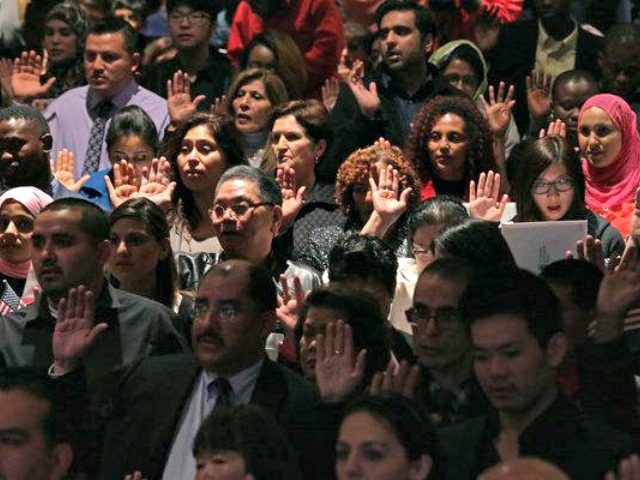The White House is dropping a longtime initiative of President Trump’s that reduces overall legal immigration levels to increase U.S. wages, a senior administration official tells the media.
Throughout 2015, 2016, and 2017, Trump routinely touted his plans to reduce the number of legal immigrants who arrive in the U.S. on a myriad of visas. Since the 1990s, when it was expanded by President George H.W. Bush, legal annual immigration levels have remained at historic highs with about 1.2 million nationals legally admitted every year.
For example, since 1980, the number of legal immigrants admitted to the U.S. every year has not dipped below 525,000 admissions. Since 1999, annual legal immigration levels have not dropped below 645,000 admissions and since 2004, the average number of legal immigrants admitted every year has not dipped below a million admissions.
Trump often touted the need for reducing legal immigration levels to “reduce poverty, increase wages, and save taxpayers billions and billions of dollars” in 2017, arguing that the current importation of more than a million legal immigrants every year “has placed substantial pressure on American workers, taxpayers, and community resources.”
Trump said of the current legal immigration system:
Among those hit the hardest in recent years have been immigrants, and very importantly, minority workers competing for jobs against brand new arrivals. And it has not been fair to our people, to our citizens, to our workers. [Emphasis added]
An immigration plan by the White House, with only preliminary details available, does not seek to reduce any forms of legal immigration to the country, a senior administration official told the Washington Post and The Hill.
“A senior administration official told reporters after the meeting that the president had approved the effort to overhaul America’s immigration system and increase border security last week and that it should now be considered ‘the President Trump plan,'” the Post reported. “… under the plan, the same number of immigrants would be permitted to enter the country, but the composition would change.”
Senator David Perdue (R-GA) — who attended a meeting with Trump on Tuesday — confirmed to Breitbart News these details of the White House plan.
“While this is still in the preliminary stage, the president has proposed maintaining the 1.1 million legal immigrants we bring in each year but changing the mix to respond to the needs of our growing economy and workforce,” Perdue told the media following the meeting.
Instead, the plan shifts the way in which the U.S. admits the more than 1.2 million legal immigrants it accepts every year.
During an interview with Time Magazine last month, senior adviser Jared Kushner said Trump’s focus for reforming the national immigration system centers on protecting Americans’ wages.
“We have a lot of objectives … Number one, he wants to protect American wages,” Kushner said.
High levels of immigration, illegal and legal, puts downward pressure on U.S. wages while redistributing about $500 billion in wealth away from America’s working and middle class and towards employers and new arrivals, research by the National Academies of Sciences, Engineering and Medicine has found.
Economist George Borjas has detailed how the country’s working class, those without a high school diploma, have been primarily hurt by the annual admission of more than a million mostly low-skilled foreign nationals.
“The typical high school dropout earns about $25,000 annually,” Borjas wrote for Politico in October 2016. “According to census data, immigrants admitted in the past two decades lacking a high school diploma have increased the size of the low-skilled workforce by roughly 25 percent. As a result, the earnings of this particularly vulnerable group dropped by between $800 and $1,500 each year.”
Center for Immigration Studies Director of Research Steven Camarota has discovered similar wage depression trends.
For every one-percent increase in the immigrant portion of American workers’ occupations reduces their weekly wages by about 0.5 percent, Camarota finds. This means the average native-born American worker today has his weekly wages reduced by perhaps 8.5 percent because of current legal immigration levels.
In a state like Florida, where immigrants make up about 25.4 percent of the labor force, American workers have their weekly wages reduced by about 12.5 percent. In California, where immigrants make up 34 percent of the labor force, American workers’ weekly wages are reduced by potentially 17 percent.
Likewise, every one-percent increase in the immigrant portion of low-skilled U.S. occupations reduces wages by about 0.8 percent. Should 15 percent of low-skilled jobs be held by foreign-born workers, it would reduce the wages of native-born American workers by perhaps 12 percent.
At current legal immigration rates, about one-in-six U.S. residents will have been born outside of the country by 2060, the Census Bureau has found. The foreign-born population in the U.S. is expected to reach 69 million in the next four decades.
John Binder is a reporter for Breitbart News. Follow him on Twitter at @JxhnBinder.

COMMENTS
Please let us know if you're having issues with commenting.